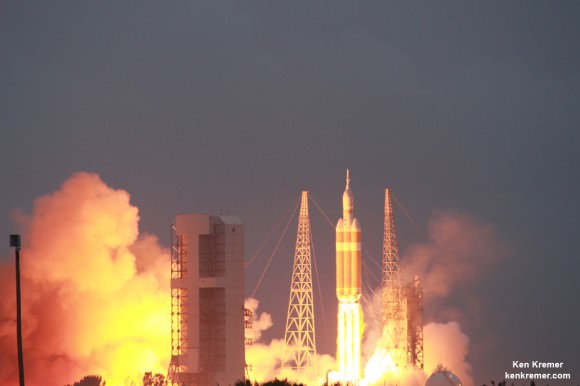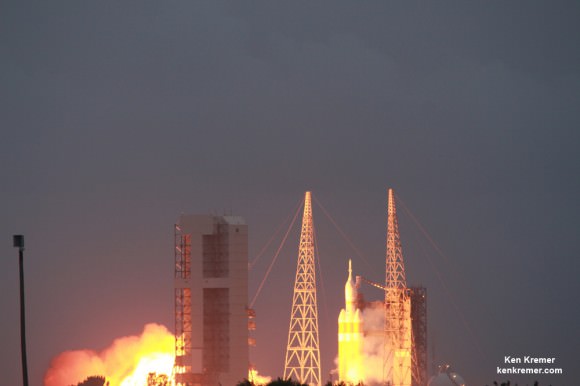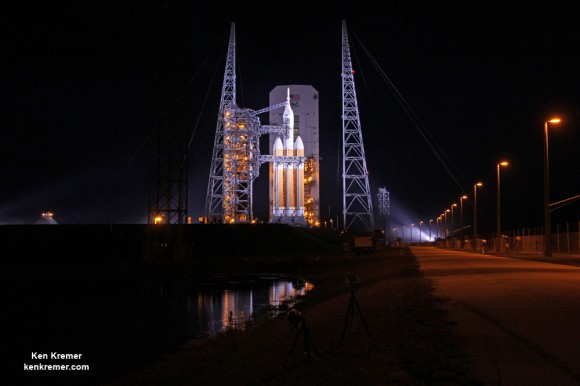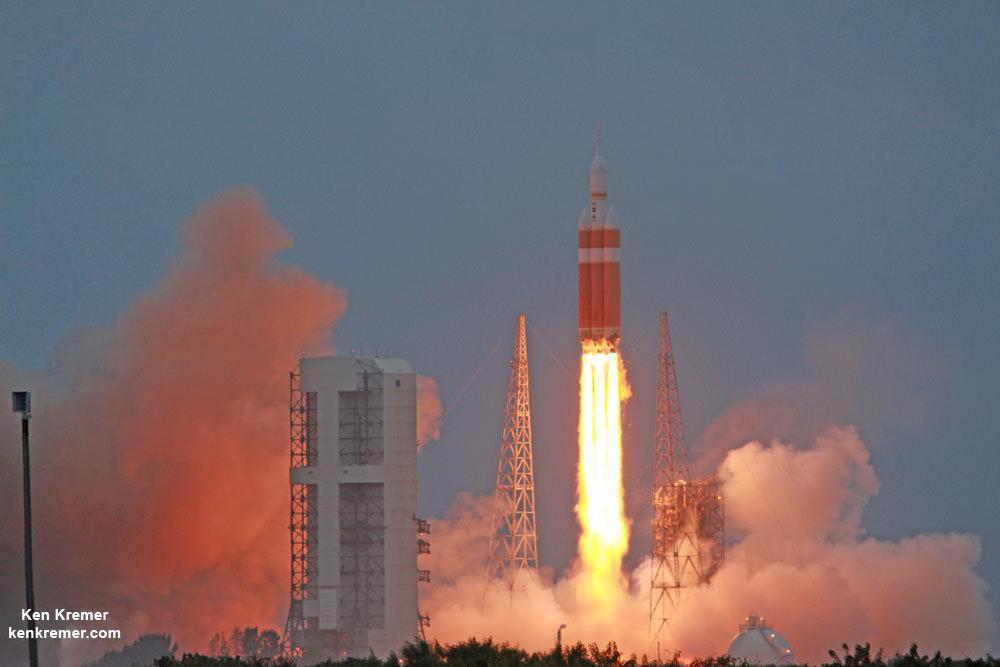KENNEDY SPACE CENTER, FL – The long road to NASA’s “Mars Era” opened with the thunderous on-time blastoff today, Dec. 5, of NASA’s first Orion spacecraft.
Orion took flight atop a United Launch Alliance Delta IV Heavy rocket on its inaugural test flight to space on the uncrewed Exploration Flight Test-1 (EFT-1) mission at 7:05 a.m. EST on December 5, 2014, from Space Launch Complex 37 (SLC-37) at Cape Canaveral Air Force Station in Florida.
“It’s the dawn of Orion and a new era in space exploration,” said NASA launch commentator Mike Curie as the Delta rocket roared to life.
Orion’s Delta rocket lit the sky on fire and soared to space on the world’s most powerful rocket.

Jubilation broke out in Mission Control as Orion slowly ascended from the pad.
“It’s a great day for America,” said NASA Flight Director Mike Sarafin.

This story is being updated directly from the Kennedy Space Center. Further details in follow up features.
Watch for Ken’s ongoing Orion coverage and he is onsite at KSC during launch week for the historic launch on Dec. 5.
Stay tuned here for Ken’s continuing Orion and Earth and planetary science and human spaceflight news.



Congratulations to NASA for successful Orion test…
Sweet success! Yes! I got up about 5AM PST, a bit late, to watch this mission. I saw most of the flight on NASA TV, but have to say that the broadcast locked up several times. The worst one was just as the capsule made it’s splash down…. dzzzzz.
I have written the NASA TV webmaster a couple times to complain about spotty broadcasts. My Comcast high speed account is now pretty good, but while watching NASA TV I’ve found that the broadcast is constantly interrupted and repeats segments of itself, usually 3-4 times to deliver full content. This makes it really hard to watch. I mentioned that I thought this would NOT look good to the G.P. as it makes NASA seem a little ‘off’ technologically speaking. I did not receive anything back from them, but noticed the performance did get better – the repeating dialog has improved, but there are still interruptions in the broadcast.
Has anyone else experienced similar?
I live in Ireland and had the same experience: frozen broadcast. So it’s not an issue with your ISP… it’s on NASAs end.
For me in western Canada, the experience proved to be a good challenge. The broadcast, aside from the usual quirks, froze completely both at launch (T minus 30 secs!) and from the time of main chutes deployment and about 20 secs after actual splashdown and an error message came from uStream. Perhaps, a lot of people alerted by others via social media about the momentous event, all tried to connect to the server(s) at the same time…
However, someone from NASA did apologized on air about the issue with the online broadcast about 40 minutes into the flight.
Since no Canadian TV service caries the free satellite feed from NASA, I think we’re stuck with an obviously popular stream that has to compete with today’s “net neutrality”.
I was also extremely disappointed by NASA live coverage. The repeats, several announcers speaking at the same time, once there were three repeats playing in a circular rhyme!; it was very unprofessional at times. Then after waiting several hours Thursday and then up again at 3:40 AM here, I enjoyed a perfect countdown, only to be cutoff at T-30 seconds and not reconnected until 4 minutes into the flight. What’s up? Just another government rollout like the medical insurance debacle. I know that it has been a huge project and deserves much praise for creating this beautiful spacecraft, but there has been an awful lot of development time and publicity for a trip that was practically like the first Mercury Project launches (on steroids)! It was a beautiful start though, and congratulations to all who made it possible.
Fantastic! I am from Wales but lived in Florida for many years and loved to watch the launches from the Kennedy Space Centre, I am now in Europe but am so happy for the USA to get back on track and I cant wait for the first manned (or woman) launch for Orion going back to the Moon or circling the Moon then later on to Mars, all the best its about time I was just about to give up hope, well done…..
Its very understanding not understandable your the uneducated that’s so Far Away Long Ago ha ha ha….
Oh come one please. Orion is hooked to a massive service module that has 2 years of energy, water, fuel, food, and stuff to read of course when it heads for Mars.
Orion is the entry module when they get back to Earth.
UMM… That’s 21 days with the capsule and service module alone… right?
Time for a stretch? How about launching an SLS with lunar expedition gear and send it to the Moon. Then launching another to the ISS, loaded with fuel. Use that fuel to raise the ISS (or parts of it) into lunar transfer orbit, then use it as an ‘in-situ’ lab to examine the asteroid brought back from NEO and as a transfer station for lunar missions. Re-supply and rotate crews with an upgraded Space-X Dragon?
I completely agree. It is a bit of a stretch 😉
Congratulations NASA – you are back to where you were on 9. November 1967.